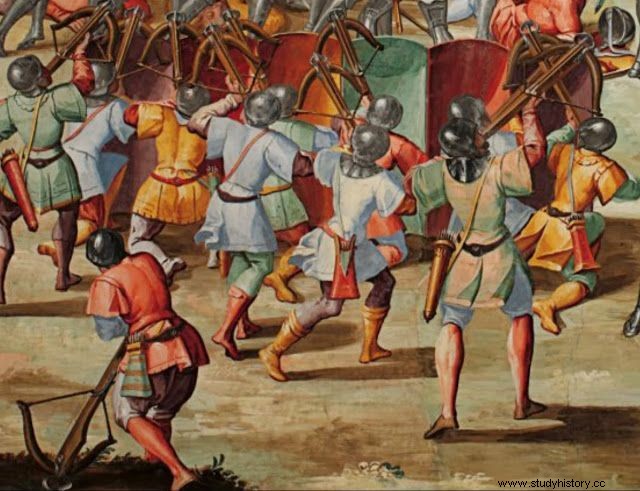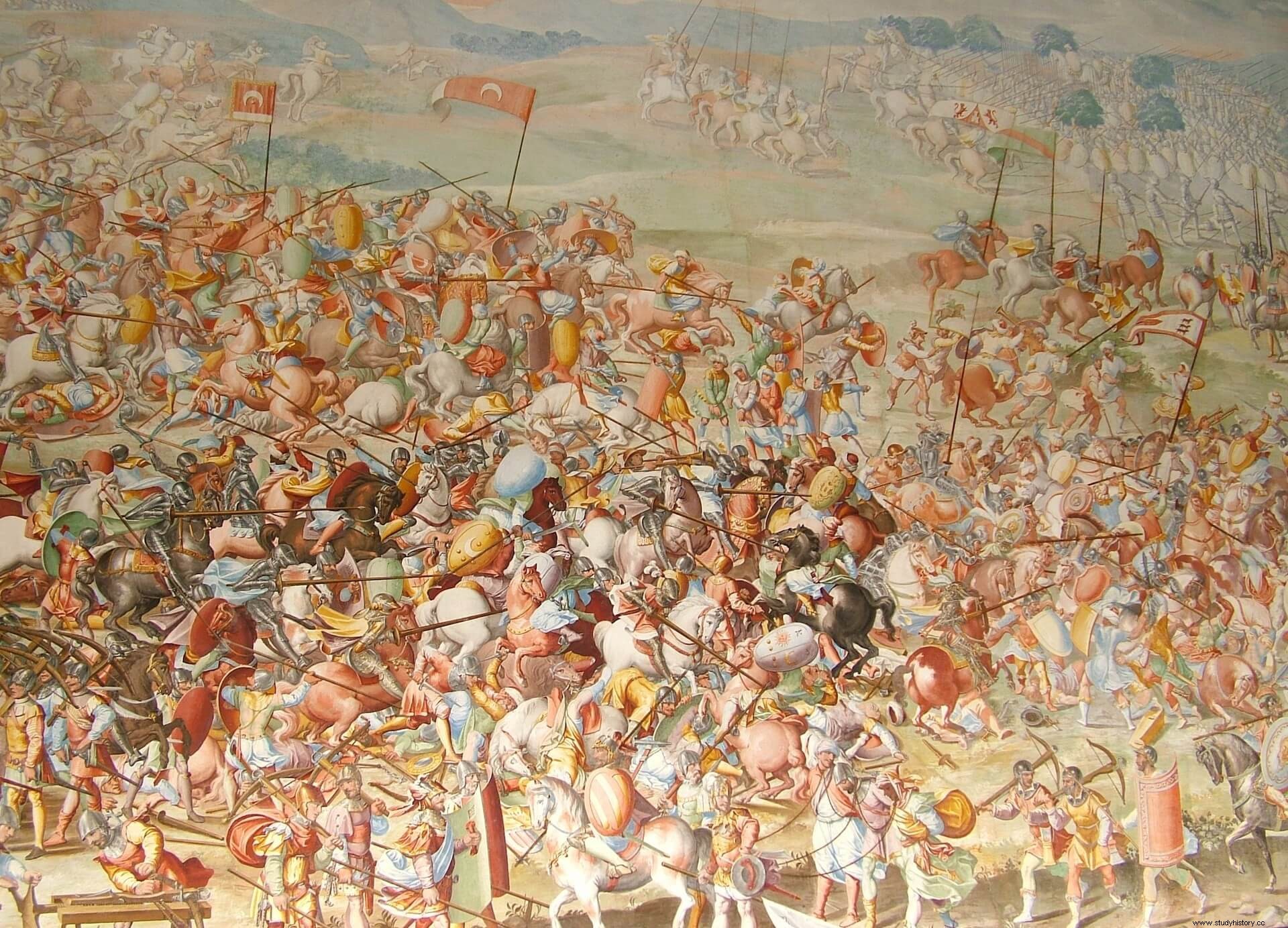
Its launch power compensated for its slow reload speed compared to the traditional bow (see "The English longbow versus the Genoese crossbow" in Desperta Ferro Antigua y Medieval #32:The Hundred Years' War I ) and its apparently simple mechanism made it easy to use and maintain, so the soldier did not have to be too trained to use it effectively. Its use against other Christians was punished with excommunication at the Second Lateran Council of 1139, because with it a simple pawn could easily bring down, dishonorably, a well-armed knight. For this reason, it was described as "deadly art and hated by God."
It owes its origin to the gastrafetes Greek (4th century BC) and the manuballista (2nd century AD) and arcuballista (h. s. IV a.C.) Roman, although it was already known by the Chinese around the s. VI BC It had a very discreet use in Christian Europe during much of the High Middle Ages until its massive use from the twelfth century. The Muslim world learned about the crossbow through two different channels:a European one that gave rise to the so-called "Christian", "French" or "foreign" bows, and an Eastern one where the "Persian bows" or jarkh , evolved from Chinese models. It is believed that they were the Muslims in the 11th century those who extended their use in the Iberian Peninsula. In the Nasrid kingdom of Granada it enjoyed great popularity, creating sections of crossbowmen on foot and on horseback, as depicted in the frescoes of the Casitas del Partal in the Alhambra (c. 1340).
Crossbow companies on the Peninsula
In the peninsular Christian kingdoms the crossbowmen were the troop chosen by the kings to carry out, mainly, escort tasks. Starting in the 12th century, the first crossbow companies were established in some towns and cities. and in the fourteenth century they enjoyed an important role in the borderlands. In the kingdom of Portugal the Ballesteros del Conto stood out. In the Crown of Aragon, apart from the brotherhood of crossbowmen from Huesca and the Brotherhood of Alarde from Zaragoza, the Centenar de la Ploma (or Glorious Saint George) based in Valencia stood out. In the Kingdom of Navarre there were companies of crossbowmen in San Vicente de la Sonsierra, in Ábalos and in Peciña in charge of garrisoning these strongholds against the Castilians. The Crown of Castile was not far behind, with two large groups:one to the north on the border with Navarre and made up of the crossbowmen companies of Calahorra, San Sebastián de Villar de Arnedo, Haro, San Millán, Peñacerrada, Marquínez and de Children of San Felipe and Santiago from Alfaro. The other nucleus was to the south, on the border with the Muslim kingdoms, where the crossbowmen of the city of Seville and the brotherhoods of La Coronada stood out. from Jaén, the one from La Vera Cru z de Vilches and the Two Hundred Crossbowmen of the Apostle Santiago de Baeza.
Most of these crossbow companies were gradually disappearing As the Middle Ages advanced and in the best of cases, after abandoning their military work, they became agents of Justice, road guards or simple charity brotherhoods. Two paradigmatic cases are the Centenar del Glorioso San Jorge de Valencia and the Company of the Two Hundred Crossbowmen of the Apostle Santiago de Baeza, which will remain a stable military force until its abolition in the 18th century. We will now develop the particular case of this last company, as an example of a militia born as a crossbow troop that knew how to maintain itself over time by adapting to the new currents of the art of war.
The Company of the Crossbowmen of the Apostle Santiago
The Company of the Crossbowmen of the Apostle Santiago was founded in 1234 to defend the border from the attacks of the emir Ibn Hud of Murcia and his vassal Alhamar de Arjona (future first Nasrid king). Its number of members was fixed at two hundred and only the king, to whom they owed absolute fidelity, could summon them. In exchange for their services, they were exempted from all council charges and the payment of taxes, also remaining outside the scope of common justice, being able to be judged only by the Crown. They adopted as a symbol a white banner with the red cross of San Andrés (emblem of their city) and an oval escutcheon in the center with the cross of Santiago. His motto was a declaration of intent:Nemini cedo neque inimicorum parco ("I will not give in to anyone nor will I have compassion on my enemies").

The company played a prominent role in the War of Granada with the conquests of Huelma (1438), Bélmez de la Moraleda (1448) and Alicún de Ortega (1486). After the fall of the Nasrid Kingdom in 1492, the Company of the Two Hundred Ballesteros expanded its field of action to the coastal defense of Andalusia, the kingdom of Granada and the kingdom of Murcia, remaining under the orders of the kings or, where appropriate, of the captain General of Andalusia, the Duke of Medina Sidonia, prohibiting his departure from peninsular lands.
To join the company, applicants had to prove before a court that they were descendants of old Christians . It could be accessed by birthright inheritance and as long as the applicant was married. After paying three pounds of wax and three reales or four ducats (if the applicant was not the eldest son), the newly elected, armed as a crossbowman and kneeling before a cross located in the Plaza del Mercado, starred in a ritual in which he lent his oath to the king and to the apostle Santiago, patron saint of the company. Military service lasted 20 years, after which the soldier was discharged.
The company's record of service to the Crown is extensive, worth a few examples to demonstrate its consideration as an elite troop at the time:
During theCommunities War of Castile remained faithful to the cause of Emperor Carlos and in 1521 he attended the League of the Rambla, which triggered his participation in the Battle of Villalar and in the subsequent capture of the community leaders, which is why they were given in Baeza with a Gothic-style triumphal arch called "Arco de Villalar".
From 1566 the company underwent a modernization of its weapons, replacing the crossbows with matchlock arquebuses . Similarly, it was reorganized into eight squads of twenty-five soldiers under the command of a corporal. With this new organization they acted during the Rebellion of the Alpujarras in 1569 with their captain Baltasar de Aranda Montemayor at the head, following the orders of the Marquis of Mondéjar and participating in the battles of Puente de Tablete and Galera, where the captain himself along with eighty and five brothers met death. The company then returned to Baeza, rejoining the fight the following year in the face of numerous requests from the commanding general, Don Juan de Austria.
In July 1596 they moved to Jerez de la Frontera and Cádiz to face the English for nine months, which cost them an outlay of 20,000 ducats. Nothing to do with the 36,000 ducats they spent in a single month in Gibraltar during the Anglo-Spanish War of 1625 . And it is that the company financed the military campaigns at its expense, which caused many of its members to go bankrupt, even needing the financial help of their other brother brothers to survive. This meant that most of its members were forced to work in manual trades in order to replenish their loss by making the capital invested in service to the Crown.
During the War of the Spanish Succession it became a regiment , increasing their number to 500 soldiers, although this circumstantial measure only lasted until 1707. Felipe V saw it necessary to reform the company by establishing an age range for his brothers that went from 18 to 60 years, he also ordered the departure of the sick that they could not bear arms and prohibited the appointment of substitutes for war without just cause. New access conditions were also established:to be between 18 and 40 years old, to be a descendant of an old Christian, not to have been punished by the Justice or by the Inquisition and not to have held vile jobs such as executioner, town crier or butcher. The entry fee varied from 200 to 400 reales de vellón.
His last known performance by him took place in 1728 during the last phases of the Siege of Gibraltar . On December 12, 1757, the Minister of War, Sebastián de Eslava, informed the city of Baeza of the decision of the monarch Fernando VI to terminate the fulfillment of the service to the Crown of this company with more than 500 years of history. , incorporating her as a colonel of the Jaén Militia Regiment.
Bibliography
- Municipal Historical Archive of Baeza (A.H.M.B.). 5/2/98; 2/10/8; 2/10/23.
- National Historical Archive (A.H.N.). TIPS, 35043, File 3; BAENA, C. 73, D. 4-19.
- Ceballos-Escalera y Gila, A. (1994):«The noble company of crossbowmen from Peciña, in La Rioja», Annals of the Royal Academy of Heraldry and Genealogy of Matritense , 3, p. 21-40.
- Cózar Martínez, F. (1884):News and documents for the history of Baeza . Jaen.
- García de Lara Torres, J. J. (2003):«The Company of the Two Hundred Crossbowmen of Lord Santiago, of Baeza», Hespérides, XX Methodological-Didactic Colloquium , p. 377-413.
- Gomes Martins, M. (2008):«The Crossbowmen of Conto in Portugal in the Middle Ages», Medievalism , 18, pp.375-395.
- Groizard y Coronado, C. (1909):«Local militias in the Middle Ages», Bulletin of the Royal Academy of History , LV, pp. 353-362.
- Ladero Quesada, M. A. (1989):«The military organization of the Crown of Castile in the Late Middle Ages», Medieval Castles of the Kingdom of León (Miguel A. Ladero Quesada, coord.), p. 11.
- Marinetto, P. (com.) (2013):Weapons and equipment for the Nasrid defense. Granada:Board of Trustees of the Alhambra and Generalife.
- Miquel Juan, M. (2011):«International Gothic in the city of Valencia. The altarpiece of Saint George in the Centenar de la Ploma”, Goya , 336, p. 191-213.
- Pérez Carazo, P. (2012):«The brotherhood of crossbowmen of Calahorra in the fifteenth century», Kalakorikos , 17, p. 439-455.
- Páez López, J. (com.) (2006):Ibn Jaldun. The Mediterranean in the fourteenth century . Seville:The Andalusian Legacy.
- Tello Hernández, E. (2013):Contribution to the study of medieval brotherhoods and their devotions in the kingdom of Aragon . Zaragoza:“Fernando el Católico” Institution (C.S.I.C.).
